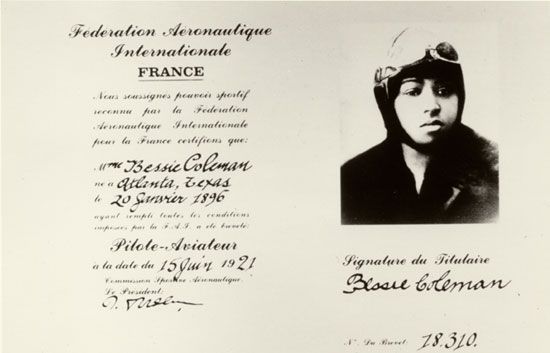The ‘Queen of the Sky’ Is Finally Getting Her Due
On her birthday, we’re remembering Bessie Coleman’s incredible achievements
/https://tf-cmsv2-smithsonianmag-media.s3.amazonaws.com/filer/e9/ca/e9ca7e46-1933-4ae9-a119-3fe3916c9a6a/queen-girls-bessie-coleman.jpg)
Born on this day in 1892, Bessie Coleman’s determination and drive made her the first African-American woman to fly.
And now she's being immortalized in a new kid’s book. Its title? Bessie, Queen of the Sky.
Coleman couldn’t learn to fly in America. No flight school would accept her, because she was black and a woman. So she learned in France, before coming back to America with her pilot’s license.
But her story is deeper than that, writes Ken Hare for the Chicago Defender. In her early twenties, around 1915, Coleman was working as a manicurist and living in Chicago when her lofty ambitions were inspired by stories of WWI pilots. She decided to learn to fly.
“Very few women of any race had pilot’s licenses in 1918,” writes PBS. But after cashing in her savings and studying French, and with support from the Chicago Defender’s Robert Abbot, she headed to France in 1920, where she spent seven months learning how to fly.
“During her training Coleman witnessed a fellow student die in a plane crash, which she described as a ‘terrible shock’ to her nerves,” writes PBS. “But the accident didn’t deter her: In June 1921, the Fédération Aéronautique Internationale awarded her an international pilot's license.”

Back in the States, her countrymen were quick to celebrate what they had denied her the opportunity to achieve, and she spent the next five years as a “full-fledged aviatrix” honored for her achievement, PBS writes. They called her “Queen Bess.”
In 1926, though, events took a tragic turn:
Together with a young Texan mechanic called William Wills, Coleman was preparing for an air show that was to have taken place the following day. At 3,500 feet with Wills at the controls, an unsecured wrench somehow got caught in the control gears and the plane unexpectedly plummeted toward earth. Coleman, who wasn’t wearing a seatbelt, fell to her death.
At least 10,000 people showed up to pay their respects after she died, PBS writes. Coleman is buried in Chicago’s Lincoln Cemetery and her name is still strongly associated with black aviation.
An action figure "adorned with goggles, vintage scarf, map and interchangeable heads" will also teach future generations about Coleman's achievement.